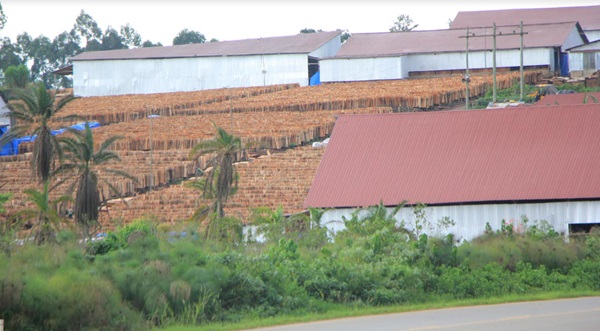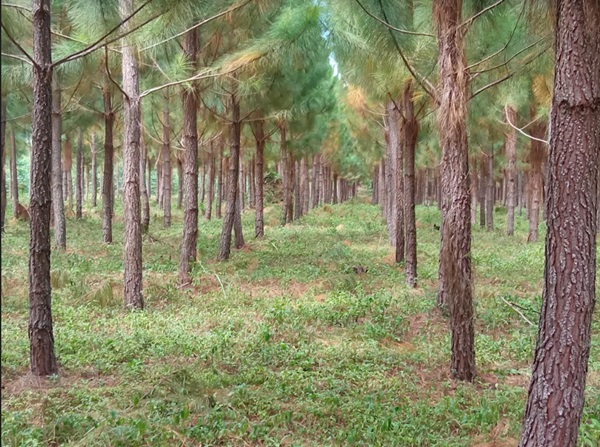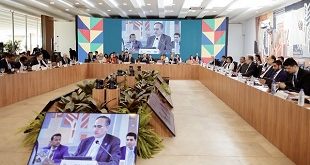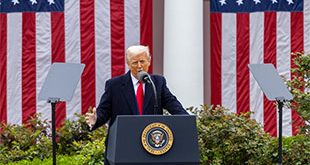
Technocrats blame Chinese veneer processors, local tree growers blame the technocrats
COVER STORY | THE INDEPENDENT | In May last year, President Yoweri Museveni banned the export of ‘unprocessed’ timber products scampering a hitherto booming wood industry. One year later, panic from Museveni’s Executive Order No.3 continues with no end in sight for Uganda’s tree growers, timber dealers and exporters, Ronald Musoke reports.
Mubende District in central-western Uganda, one of the country’s most plantation-forested districts, has probably taken the hardest hit from President Yoweri Museveni’s one-year-old moratorium on the export of unprocessed timber.
Until June last year, there were up to eight saw mills, seven of which were Chinese-owned, operating in the district. Regular travellers who use the Kampala-Mubende highway would often have seen small, medium trucks, and even trailers, hauling logs to the veneer factories along the route.
Inside most factories, workers stripped and sliced the logs into thin sheets of wood known as veneer. These would be sun-dried, packed and then exported to China. Similar scenes played out in the neighbouring districts of Mityana, Kibale and Kyegegwa.
Forest products entrepreneurs involved in the business; tree growers, workers in the plantations and factories, the Chinese investors and even the local governments, seemed happy with the arrangement.
“A factory could employ over 100 people and the plantation owner could employ over 50 people including transporters, loaders, power-saw operators and many others. The districts collected millions of shillings daily from vehicles transporting the wood,” a senior official working with Mubende District Local Government told The Independent in March this year.
Edith Kizza, a timber dealer in Mubende town told The Independent about the boom. “We would sell the logs in large numbers and in just a few days they would get finished; we were really working with good profit.”
Kizza who has been involved in the timber business for the last 20 years told The Independent that before the Chinese veneer entrepreneurs arrived, a loaded 10-wheeler medium-size dump truck locally known as “Tipper” used to go for Shs 60,000 – 80,000 (US$16-21.50). When the Chinese arrived, the price for the same load of logs was doubled to Shs 150,000 (US$40) and in other instances tripled.
The thriving forest products sector also attracted large scale tree growers such as New Forests Company, Busoga Forestry Company and Global Woods. Nationwide, it is estimated there were about 40 saw mills and wood factories.
Govt’s tree cover recovery efforts
The government has over the last 20 years been struggling to grow back the country’s forest estate which had dwindled to 9% (or 1.8 million hectares) of Uganda’s total landmass in 2015 from 24% in 1990 (4.9 million hectares). The ambitious plan is to restore the forest cover to the 1990 level by 2030.
In 2015, the government joined the Bonn Challenge; a global initiative that seeks to bring 350 million hectares of deforested and degraded land around the world into restoration by 2030. Uganda committed to restore up to 2.5 million hectares of its degraded forests.
Ugandan entrepreneurs were given funds to grow tree plantations as a business using a European Union-funded Sawlog Grant Production Scheme (SGPS) which kicked off in 2004. Thanks to the successful programme, current estimates by the National Forestry Authority (NFA) put Uganda’s forest estate to about 14% of the total landmass in 2020.
But recovery efforts have also meant that most of the eucalyptus and pine plantations that private tree growers have planted and nurtured over the last two decades have now matured and are ready for harvesting.
‘Unprocessed wood’ export ban
This explains the recent influx of Chinese entrepreneurs into the Greater Mubende area. But what appears to be a deal for tree growers from the Chinese investors, is seen as an environmental disaster by the government. Apparently, on average, each Chinese factory has been consuming an acre a day with each acre of cut trees filling about 15 trucks.
“This was a big threat to the environment because the consumption was not sustainable,” the Mubende District official told The Independent. And so, suddenly, in a presidential directive issued on May 24 last year, President Museveni said all saw mill and wood factories nationwide were to immediately stop exporting of what he referred to as “unprocessed timber products.”
The Independent understands Museveni made the decision after being told that Uganda was losing millions of dollars in revenue and that the lumbering was unregulated and threatening the country’s forest cover recovery efforts.
Tree growers, timber dealers and exporters felt the ban’s impact almost immediately. John Ferguson, the Managing Director of Busoga Forestry Company spoke of how the company had to temporarily close its sawmill and now operates at 40% capacity. Ferguson also said the company has had to put a hard stop on at least one very valuable export contract.
“The government is obviously trying to protect Uganda’s indigenous timber resources, but the interpretation has expanded to include all timber products,” he said.
“There is no cohesion of understanding between the various ministers as to what timber products are. We fail to see the logic as one is allowed to export plywood, woodchips, and saw dust, as well as pallets, but one can’t export the sawn timber that the saw dust comes from,” he said.
Posiano Besesa, an elderly tree grower and forest products entrepreneur of 40 years from Mubende District, recently told The Independent that Museveni’s directive has hit hard.
“Right now I regret why I invested in forestry,” he said. Besesa told The Independent that Museveni’s executive order was not backed by research and was uncalled for. “It did not take into consideration the realities that are present in our country,” he said, “Instead of halting deforestation, this executive order has just exacerbated it.” He says people who started seeing value and money in tree growing are pulling out.
Not a knee-jerk reaction
But Tom Okello Obong, the immediate former Executive Director of the National Forestry Authority (NFA), the national agency responsible for conserving the country’s forest resources, told The Independent that contrary to what many in the sector referred to as a knee-jerk reaction, the president’s executive order was informed by physical observation and scientific data and satellite imagery.
Okello said the NFA does periodic forest cover mapping and disaggregates the data up to district level.
“That is what we recently did and found massive forest cover losses in the Greater Mubende Area,” he said. According to him, before the Chinese arrived in the Mityana-Mubende axis, there were only a handful of known small plywood factories in Jinja, Mukono and Nakasongola districts.
He said after the Chinese arrived, the government observed wood product export shifting from raw timber and logs to veneer shipment to China. For instance, in the one year period prior to the ban (July 2022-June 2023), Uganda exported veneer worth US$23.8 million (Shs 88.5bn).
“The sudden transition from raw timber to veneer woke-up the government,” he said, “We saw that there was decreasing proportion of rough wood export; in other words, instead of exporting the wood, they favoured veneer exports.”
Okello insists veneer is a low-value added product. “What people don’t realise is that plywood is not veneer; veneer is a raw material for plywood, and other products such as paper, automobile accessories and floor materials,” he said.
“The low prices from veneer exports raised concerns and as a country, we needed to put our foot on the ground and go for what we feel is best for us,” he said. He said a square metre of wood-based ‘floor tiles’ could cost 10 times more than the same measurement of veneer.
Another problem was exposed in a November 2022 report prepared by the African Development Bank (AfDB) on the economic performance of the timber industry in East Africa. In the report, the bank’s African Natural Resources Management and Investment Centre noted that a comparison of Chinese and Ugandan import/export data found that neither country reported their log exports to the other but both reported the import of logs from the other. This trade discrepancy was assumed to result from illegal trade.
Okello said government trade statistics from July 2022 to June 2023 had also shown a shift in Uganda’s wood exports to China. For example, over the last decade, the export revenue from wood products rose from US$ 12.4 million to US$ 48.6 million. This increase was not generated by increase in export volume but rather, it was an increase in low-level value addition (veneer production).
Reversal of forest cover gains
Okello further told The Independent that when the NFA studied the tree cover trends in the affected districts, “the results were shocking.” Mityana District in central Uganda which by 2017 had about 3,264 ha of tree cover saw a quick rise to 8,000 ha by 2019. But by 2021, the tree cover had dramatically dropped to 5,400ha. The same happened in Mubende, Kyegegwa and Kibaale districts. Okello said only Hoima District escaped the reversal, with forest cover growing from 2,396ha to 2,883ha.
“This is what prompted the president to ban the export of veneer from Uganda,” he said, “We all agreed that the country had a problem and the ban on veneer exports was done to save the country from deforestation. “Yes, we are missing export revenue but we should not only think of getting dollars at the expense of the country’s environmental health.”
Okello said it is a misconception for plantation tree growers to say the President’s Executive Order was rushed because they feel they have a lot of timber which can supply the market.
“As someone involved in policy making, I would tell you that in natural resource management, there is nothing like “a lot” because resources can be depleted unless we strike the sustainable yield level,” he said, “One must calculate and know how much one is producing; how fast the trees are growing and how much timber one expects to harvest so that they remain in business for long.”
But Besesa argues that when the Chinese arrived in Uganda, they were actually issued with government licenses to trade in veneer. “Perhaps those responsible for issuing licences did not understand what comes out of veneer,” he said.
Government ignores local tree growers
Dennis Kavuma, the Chief Executive Officer of the Uganda Timber Growers Association (UTGA), an umbrella body which comprises about 800 commercial tree growers in the country told The Independent in March that, currently, Uganda has about 330,000 hectares of commercial plantation; 130,000 hectares of which are owned by UTGA members.

According to UTGA, however, the country is grappling with an ineffective law and policy and even if the government pushes through with it, it is not yet clear whether there is a ready market for all the value-added wood products.
“For you to convert a tree into a high value product is a process which requires technology, expertise, hands and a market. It requires a series of things. Now, for us to just do that abruptly is impossible. We think it is a gradual process.” Kavuma told The Independent that tree growers don’t have a local market for their produce.
Kavuma’s concerns were confirmed when The Independent paid an impromptu visit to one of the many timber yards that dominate Ndeeba, a Kampala suburb renowned for being the busiest hub for timber dealership in Kampala.
Young men were busy loading a blue 22-wheeler trailer with timber. Two more trucks, including a medium-size 10-wheeler truck and a smaller truck were on the ready to be loaded with more timber. Business appeared brisk. But a female supervisor said business was actually low.
She said before Museveni issued the moratorium on export of unprocessed timber, most of the contracts her boss got were from South Sudan and Kenya. But she said the timber on the 22-wheeler truck was headed for northwestern Uganda.“We are at the moment stuck because Ugandans don’t buy a lot of our timber,” she told The Independent in April.
Interestingly, since September, last year, the UTGA has written two letters to President Museveni, and one letter to the Speaker of Parliament. It has also reached out to the Ministries of Trade; Water and Environment and other agencies looking for a way forward. The association says it has not got any response.
As the impasse continues, Ugandan tree growers appear frustrated. So too are people who have been working in nursery beds and tree plantations who suddenly find themselves without jobs.
Many of them are widows and young men and women desperate for jobs. For tree farmers whose trees are mature for harvesting, some of them are having to sell a 10-year old eucalyptus or pine tree for as a little as Shs 20,000. In other places, some are buying an acre of mature eucalyptus trees for as little as Shs 6 million.
An acre could have about 200 mature trees; meaning the average mature tree which has been kept on the plantation for at least 10 years is going for Shs 30,000. A source says before Museveni’s directive, the same tree could have cost four times more. The buyers are now taking advantage of the presidential directive-induced glut to buy at really low prices.
Poorly regulated industry
Yet, even when the local players appear to be in the dark with regards to what is going on, Beatrice Atim Anywar, the State Minister for Environment told The Independent that President Museveni’s directive still stands and its implementation is still on.
The directive does not only bar export of unprocessed wood products abroad, it also includes a ban on imports of furniture into Uganda, she said. “We cannot be the ones providing raw materials for factories abroad. They should be able to come here and invest,” she told The Independent.
Onesmus Mugyenyi, the Deputy Executive Director of the Advocates Coalition on Development and Environment (ACODE) told The Independent that considering so much investment has been sunk into the forestry sector over the last 20 years by the donors, the government probably felt under pressure from the funders.
Still, Mugyenyi, who also heads the environment programme at ACODE, a Kampala-based public policy think tank says the President did not think through the implications of the ban. He said local and international forest products entrepreneurs had sunk in a lot of resources, they had markets they were contracted to supply, and were complying with the laws.
“They are now confused. They don’t know what to do and are probably wondering what kind of country Uganda is. Even if you want factories to process this timber, it takes time, people have to plan.”
Godber Tumushabe, the Associate Director of the Great Lakes Institute for Strategic Studies, a Kampala-based public policy think tank also told The Independent that President Museveni’s executive order just demonstrated “the adhoc nature with which he runs his government.”
“Right now, the value-addition infrastructure is non-existent. You can’t have it by making pronouncements as if you are God. He should have compelled his technical people to come up with a paper on how to create the infrastructure that would help Uganda’s emerging wood industry to thrive.”
Efforts by The Independent to talk to Alfred Okot Okidi, the Permanent Secretary of the Ministry of Water and Environment, were ignored by him. But TThe Independent understands the Water and Environment ministry has over the last one year been working on a policy instrument that is intended to streamline Uganda’s forest products sector. This is expected to be issued anytime from now.
Indeed, a World Bank report published in June 2022 noted how the Ugandan tree plantation sector is often seen as a success story, and how large numbers of small and large investors have entered the sector. However, it noted, the industry’s full potential has not materialised and the industry is now at a crossroads: it needs to find ways to address the emerging imbalance in the market and to increase production value.
Okello also told The Independent that the government has struggled to regulate Uganda’s wood industry and timber and other products are still sold informally, leading to huge revenue losses to the government.
“We have been having people exporting plain timber to Kenya, South Sudan and other countries; they would simply chop down a tree, cut out the timber, dry it and pack it in trucks and export it.”
Counter-productive directive?
For Clement Okia, an Associate Professor in the Department of Environmental Science at Muni University in the northwestern city of Arua, the directive on the ban of unprocessed timber could be counter-productive to the gains Uganda had made in restoring the forest cover.
“While I can understand the government’s concern on the need to add value to tree products, it’s important to be aware that timber and plywood are already value-added products from forestry point of view and it’s traded globally,” Okia said. “The directive could have been restricted to tree logs and not timber.”
Dr. Okia told The Independent that; going forward, the government will have to set up mechanisms to regulate trade in tree products based on the International Forest Stewardship Council model. Most of the large scale tree growers and plantation timber producers in Uganda subscribe to this scheme which promotes environmental, economic and social considerations and facilitates international trade in certified forest products.
For the elderly forester, Posiano Besesa, the cold treatment that has been given to tree growers by the government is what continues to baffle him. He says the decisions taken recently have been done by “people who don’t know what it takes to plant a tree and raise it.”
“They would have invited us for a hearing so we give them our ideas of how to go about this government decision,” he told The Independent, adding that the same would have been extended to the Chinese investors.
“They would have given a specific time frame, say, one year, to upgrade the value-added timber products (plywood, block-boards or chips).
“This is what South Africa has done,” he said, further adding: “If you think the Chinese are taking away too much, why not empower the local entrepreneur such that when they sell their trees, some of them can be encouraged to venture into value addition?”
***
This story was produced in partnership with InfoNile with funding from the Earth Journalism Network. A journalist from Vietnam who requested anonymity to protect their safety contributed reporting from East Asia
 The Independent Uganda: You get the Truth we Pay the Price
The Independent Uganda: You get the Truth we Pay the Price




For your information people are still exporting hogs and plywood. The exportation was never stopped permanently. Some few companies still have their permits and export just as others used to
Museveni is a dictator and a big economic disaster to Uganda’s economic progress. He is a big problem to what would be a booming economy, and the money from oil is all that he now thinks about at the expense of other sectors. The other economic boomers -banking, telecommunications and insurance are all foreign owned. The owners take away the money. The few Ugandans that associate or deal with these foreign companies have made some money and sent their kids to study in good foreign schools, not Ugandan schools! Museveni is a loof, people are grappling with poverty. He is talking of planting trees but low market and inadequate policy has stopped people from planting trees. Only in the top list of poor countries such as Uganda you find these things. FORMER CEO-Okello was the biggest problem to the forestry. Under his tenure, so many lincenses were given to Chinese to export VENEER. He also sold most government trees. What they should have banned was the export of veneer, firewood and logs, not timber. What is required is a systematic policy of planting, harvesting and restoration all driven by mainly the market and properly regulated.